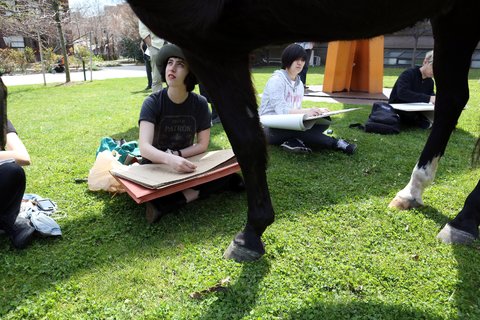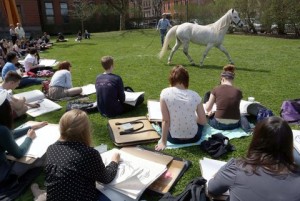
From the New York Times
Jordan Judd did something on Wednesday that art students do not usually do: He walked away with one of the models.
Mr. Judd, 22, is a senior at Pratt Institute, the art and design school in Clinton Hill, Brooklyn. The model, who is 17, was one of two that students had been sketching on the lawn behind the library.
Mr. Judd said the conversation began innocently enough. He whispered hello. “Lucille” — he found out her name in no time at all — “was kind enough to say ‘hello’ back and say, ‘Let’s go for a stroll,’” he explained.
So he took hold of Lucille’s halter and led her off.
Lucille is a horse.
She and Mr. Judd did not go far — just a few steps, though he joked about riding off to Downtown Brooklyn. She and her stable mate, Gracie, spent the day on the Pratt campus so students could draw them from life, which some students said was a different experience from drawing from a photograph. “You can learn from pictures,” said Mae Armenante, 18, a freshman from Oradell, N.J., “but having the real thing is so much cooler.”
Like the return of the swallows to Mission San Juan Capistrano in California, the arrival of the horses is a much-anticipated moment, at least at Pratt. Unlike the swallows, though, the horses do not arrive under their own power. Lucille, a brown quarter-horse, and Gracie, an Andalusian Welsh cross, endured a four-hour trailer ride from Tyler Hill, Pa. Their trainer, Ben Goldberg, had a sour look and a single word to describe the traffic: “Unpleasant.”
 The drawing of horses outdoors has been a spring tradition at Pratt for several years.Suzanne DeChillo/The New York Times The drawing of horses outdoors has been a spring tradition at Pratt for several years.
The drawing of horses outdoors has been a spring tradition at Pratt for several years.Suzanne DeChillo/The New York Times The drawing of horses outdoors has been a spring tradition at Pratt for several years.
The horses got their first glimpse of the Pratt campus about the time some students were probably just rolling out of bed. They ate a midmorning meal from chewy bales of grass that Mr. Goldberg had stowed in the trailer. They were watered and groomed, and they were photographed by students like Ms. Armenante, who was taking a break from a class on light, color and design.
Then the portraiture got under way, as students with sketch pads settled onto the lawn opposite the landmark main building, a Romanesque Revival fortress that was heavily damaged in a fire in January. The students sat cross-legged in the sun, their backs to the 1887 building, squinting, staring and squinting again.
“When you look at a horse, you think, ‘Oh, a brown horse,’” said Caroline La Douce, 18, a freshman from Elmira, N.Y., as she sketched Lucille. “You don’t realize there are all these different colors, the way the light hits her coat.”
Mr. Goldberg said horses present a particular challenge. “Picasso mentioned — no, not Picasso, I’m not an artist — but some famous artist said horses are hard to draw,” he said.
So are other kinds of animals not often seen on the Pratt campus, according to some of the students. “My teacher said Disney, for ‘Bambi,’ they spent three months in a room with a deer, just straight drawing,” said Maggie Iapoce, 18, a freshman from Woodstock, N.Y.
Gracie the white pony.Suzanne DeChillo/The New York Times Gracie the white pony.
But back to horses. Sarah van Ouwerkerk, the professor who arranged for Lucille and Gracie to visit the campus, published “Horse Beautiful” in 2006, a collection of her photographs of horses. She said she had inaugurated the once-a-year horse modeling in the mid-1990s and even brought her own horses one year.
“They said, ‘I want to go home,’” she said. “They weren’t too happy.”
Thomas F. Schutte, the president of Pratt, remembered the time an elephant from the Ringling Brothers and Barnum & Bailey Circus was brought in. He said that seeing animals up close teaches art students a number of important lessons.
“One is the anatomy,” he said. “Anatomy is extremely important and extremely complex. A second is using different drawing techniques. Their sketches will be reviewed by the faculty, and critiqued.”
Ms. Van Ouwerkerk said that less massive models had proved less successful. “We tried a miniature goat,” she said, “but the goat wouldn’t sit still for anyone to draw, and ran away. A panic-stricken country goat thrown into the art world of Brooklyn. Wouldn’t you be scared?”
